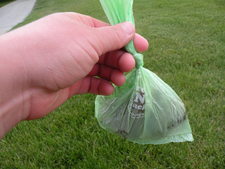The Scoop on Dogs and the Environment
In America, we love our dogs! According to the 2012 U.S. Pet Ownership and Demographics Sourcebook, roughly 1/3rd of all households have at least one dog. That’s over 43 million household and almost 70 million dogs! As any dog owner could tell you, that is also a lot of canine feces, or, “puppy poo."
Popular opinion on this topic is often dismissive. People say things like, “the rain will take care of that,” or “it’s just fertilizing the lawn,” or even “it’s what everybody does.” These are not only excuses, but flat out wrong.
Rain might remove it from your yard, but where does it go from there? The excrement, along with the storm water runoff, enters our storm drains and then into our local water bodies. This is a problem because a single gram of dog waste contains 23 million fecal coliform bacteria. The EPA actually considers pet waste to be a nonpoint source pollutant!
What about the idea that it is “fertilizer,” or that it is good for your lawn? In reality, dog waste has too many nutrients for your lawn and leaves a “burn” in the grass where the waste has sat. And, like fertilizer, once it has entered our water bodies, it contributes to algae blooms and the oxygen-depleted dead zones that inevitably result.
Does it matter if “everybody does it”? The EPA estimates in two or three days 100 dogs could contribute enough bacteria to temporarily close down swimming and shell-fishing in a bay and all watersheds within 20 miles of it. If 100 dogs could produce that much contaminant in two or three days, imagine what 70 million dogs could do in a year! This is most definitely not a case where more is better.
But what can we do about it? The classic solution, of course, is to bag up your dog’s poo and put it in the trash using a biodegradable bag. This method is tried and true – and probably your best option. But you might be wondering: are there any acceptable alternatives?
The EPA does not recommend that you compost it. Pet waste simply has too many risks associated with it to ever be used for growing of food. And it would require particularly careful composting to ensure enough heat in the composting pile to completely break down the parasites.
Can you flush it? According to the EPA, you can “as long as the droppings are not mixed with other materials.” Of course, you’re still going to want to throw the baggie in the trash. But if your dog poo comes up with too much debris from the yard where it was dropped, it may cause your system some trouble.
What about burying it? The EPA suggests a hole at least one foot deep with no more than three to four inches of waste at the bottom. With 8 inches of soil on top you should be safe from the poo being dug up by rodents. Preferably, the waste is chopped up and mixed into the soil with a shovel. Also, make sure your water table isn’t too high; otherwise the feces could seep into the ground water.
(Cat owners, take note: the risk of toxoplasmosis means that these alternative options are off limits for you!)
We hope you love your pups as much as we love ours. And we hope you act responsibly when it comes to picking up after them!

